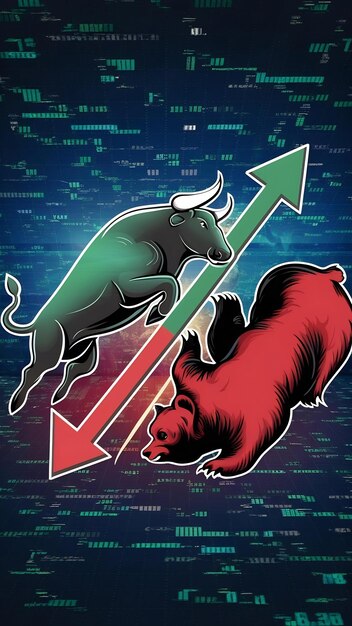What is The Formula For The Bull Bear Ratio? In forex trading, there’s a lot of technical analysis and strategies that traders use to make sense of market movements.
But one of the most interesting tools you can use to understand market sentiment is the Bull Bear Ratio.
So, what is the formula for the Bull Bear Ratio? In this article, we will look into this formula, explain how it works, and why it’s so important for traders.
You’ll also learn how to calculate it, its pros and cons, and how you can apply it to your trading strategies.
This concept may sound a little complicated at first, making sure it’s clear and easy to understand.
So, grab a pen and paper because, by the end of this article, you will know exactly how to use the Bull Bear Ratio to your advantage and also get to know the formula.
In This Post
What is the Bull Bear Ratio?
The Bull Bear Ratio is a simple but powerful tool that measures the market sentiment between two types of traders: bulls and bears.
Let’s explain this in simpler terms:
- Bulls are traders who believe the market will go up. They expect prices to rise, and they usually buy assets with the hope of selling them later at a higher price.
- Bears are traders who believe the market will go down. They expect prices to fall, and they usually sell assets to buy them back later at a lower price.
The Bull Bear Ratio helps you gauge the balance between these two groups. It tells you whether more traders are optimistic (bulls) or pessimistic (bears) about the market.
Now, the formula for the Bull Bear Ratio is:
Bull Bear Ratio = Number of Bullish Traders / Number of Bearish Traders
In other words, you take the number of traders who think the market will rise (bullish) and divide that by the number of traders who think the market will fall (bearish).
This ratio gives you an idea of the overall sentiment in the market.
How to Calculate the Bull Bear Ratio
Let’s go step-by-step on how to actually calculate this ratio.
Step 1: Determine the Number of Bullish Traders
You can get this data from market reports, trading platforms, or sentiment indices that track the number of traders who are buying and selling.
The number of bullish traders will reflect those who are betting on the market going up.
Step 2: Determine the Number of Bearish Traders
Next, you need to find out how many traders are betting on the market going down. This number can also be found in market sentiment data or trading platforms.
Step 3: Plug the Values into the Formula
Once you have both numbers, just plug them into the formula:
Bull Bear Ratio = Number of Bullish Traders / Number of Bearish Traders
Example Calculation
Let’s say that, in a particular market:
- 150 traders are bullish (expecting the market to rise).
- 100 traders are bearish (expecting the market to fall).
The Bull Bear Ratio would be:
Bull Bear Ratio= 150 / 100 = 1.5
This means that for every bearish trader, there are 1.5 bullish traders. This suggests that the market sentiment is leaning more toward optimism (bullish), and traders are expecting the market to rise.
Interpreting the Bull Bear Ratio
Once you’ve calculated the Bull Bear Ratio, the next step is to interpret it. Below is how to think about it:
- Bull Bear Ratio > 1: If the ratio is greater than 1, it means there are more bullish traders than bearish traders. This suggests that the market sentiment is positive, and traders expect prices to rise.
- Bull Bear Ratio = 1: If the ratio is equal to 1, it indicates a balance between the number of bullish and bearish traders. The market sentiment is neutral, and it could go either way.
- Bull Bear Ratio < 1: If the ratio is less than 1, it means there are more bearish traders than bullish traders. This suggests that market sentiment is negative, and traders expect prices to fall.
Why is the Bull Bear Ratio Important in Forex Trading?
The Bull Bear Ratio is important because it gives traders an insight into the market’s mood. Understanding whether traders are more optimistic or pessimistic can help you make better trading decisions.
Below are some reasons why this ratio matters:
1. Market Sentiment
It helps you understand the general mood of the market. If there are more bullish traders, the market will likely experience an upward movement.
If there are more bearish traders, the market may be headed for a downturn.
2. Trend Confirmation
If the Bull Bear Ratio is consistently high, it can confirm that a strong uptrend is in place. Conversely, if it’s consistently low, it can signal that a downtrend may be starting or continuing.
3. Contrarian Indicator
Some traders use the Bull Bear Ratio as a contrarian indicator. If the ratio is extremely high, meaning almost everyone is bullish, this can signal that the market is overbought and may soon reverse.
On the other hand, if the ratio is extremely low, it can indicate that the market is oversold and a reversal may happen soon.
Pros and Cons of the Bull Bear Ratio
As with any tool in trading, the Bull Bear Ratio comes with its strengths and weaknesses.
Let’s look into the pros and cons of using this ratio in your forex trading.
Pros
- The formula is easy to calculate. Even beginners can quickly understand it and apply it to their trading strategies.
- It provides a clear view of the market’s sentiment. Knowing whether traders are generally optimistic or pessimistic can give you an edge in predicting market movements.
- When combined with other technical indicators, the Bull Bear Ratio can help confirm market trends. This can be useful for both trend-following and contrarian strategies.
- Some traders use it as a contrarian tool. If the ratio shows an extreme in one direction, it can signal a potential reversal, allowing traders to take advantage of market corrections.
Cons
- The Bull Bear Ratio is based on trader sentiment, which can be slow to change. This means it might not always reflect immediate market conditions or short-term movements.
- The ratio simply measures sentiment and doesn’t predict exact market movements. It can give you a sense of the market mood, but it doesn’t guarantee that prices will go in the expected direction.
- Relying too heavily on the Bull Bear Ratio without considering other factors (such as economic data or technical indicators) can be risky. It should be used as part of a broader trading strategy.
- The ratio reflects the number of bullish and bearish traders, but it doesn’t account for the size of positions. A small group of traders with large positions can have a bigger impact on the market than a large group of smaller traders.
How to Use the Bull Bear Ratio in Your Forex Strategy
Now that you understand what the Bull Bear Ratio is, how to calculate it, and its pros and cons, let’s look into how you can use it effectively in your forex trading strategy.
- Use the ratio to confirm existing trends. For example, if the ratio is above 1 and the market is in an uptrend, this can confirm that the trend is likely to continue. If the ratio is below 1 and the market is in a downtrend, this can confirm that a bearish trend is likely to persist.
- Consider using a contrarian approach if the Bull Bear Ratio shows extreme values. For instance, if the ratio is very high and nearly everyone is bullish, it could indicate that the market is overbought, and a price reversal might be coming soon.
- Don’t rely solely on the Bull Bear Ratio. Combine it with other indicators like moving averages, Relative Strength Index (RSI), and Fibonacci retracements to get a more complete picture of the market.
FAQs About the Bull Bear Ratio
How accurate is the Bull Bear Ratio in predicting market movements?
- The Bull Bear Ratio is not always 100% accurate. It helps you understand the sentiment of the market but doesn’t guarantee that prices will move in a certain direction. It’s best used in combination with other technical indicators.
Can I use the Bull Bear Ratio for other markets besides Forex?
- Yes, the Bull Bear Ratio can be applied to any market where sentiment plays a role, including stocks, commodities, and cryptocurrencies.
How often should I check the Bull Bear Ratio?
- It depends on your trading strategy. If you’re a day trader, you might check it multiple times a day. For long-term traders, checking it once or twice a week could be enough.
Is the Bull Bear Ratio suitable for beginners?
- Yes, the Bull Bear Ratio is easy to calculate and understand, making it a good tool for beginner traders. However, it should be used alongside other indicators for more informed decision-making.
Conclusion
The Bull Bear Ratio is a simple yet powerful tool for gauging market sentiment in forex trading and it’s formula.
By understanding how to calculate and interpret the ratio, you can gain valuable insights into whether the market is leaning more toward optimism or pessimism.
Whether you use it to confirm trends or as a contrarian indicator, this ratio can help you make more informed trading decisions.
However, remember to always combine it with other indicators and strategies to enhance your trading success.
By incorporating the Bull Bear Ratio into your forex trading strategy, you can stay ahead of the curve and make smarter, more confident trades!




